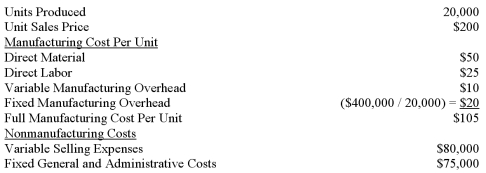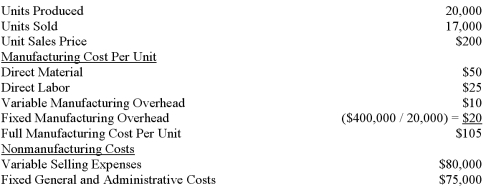A) total cost plotted on the vertical axis and activity on the horizontal axis.
B) activity plotted on the vertical axis and contribution margin on the horizontal axis.
C) contribution margin plotted on the vertical axis and sales revenues on the horizontal axis.
D) the vertical axis measured in units and the horizontal axis measured in dollars.
F) A) and B)
Correct Answer

verified
Correct Answer
verified
Multiple Choice
The unit contribution margin
A) equals total sales revenue minus total variable costs.
B) equals total contribution margin times total units.
C) tells us how much each additional unit sold will increase profit.
D) equals overall profit per unit.
F) All of the above
Correct Answer

verified
Correct Answer
verified
True/False
The least-squares regression method uses all of the available data to find the best fitting line.Least-squares regression is a statistical data that uses all the available data to find the best fitting line.
B) False
Correct Answer

verified
Correct Answer
verified
Multiple Choice
What is the difference between full absorption costing and variable costing?
A) In full absorption costing,all of the non-manufacturing costs are expensed.In variable costing,all of the non-manufacturing expenses are included in the cost of the product.
B) In full absorption costing,fixed manufacturing overhead is expensed.In variable costing,fixed manufacturing overhead is included in the cost of the product.
C) In full absorption costing,fixed manufacturing overhead is included in the cost of the product.In variable costing,fixed manufacturing overhead is expensed.
D) Variable costing must be used for external financial reports while full absorption costing can only be used for internal reporting.
F) A) and B)
Correct Answer

verified
Correct Answer
verified
Multiple Choice
Elm uses the high-low method of estimating costs.Elm had total costs of $250,000 at its lowest level of activity,when 5,000 units were sold.When,at its highest level of activity,sales equaled 10,000 units,total costs were $390,000.Elm would estimate variable cost per unit as
A) $70.00.
B) $45.50.
C) $28.00.
D) $52.71.
F) A) and C)
Correct Answer

verified
Correct Answer
verified
Multiple Choice
Regression analysis is a cost-estimating approach that uses _______________ to find the cost line.
A) only two data points
B) all available data points
C) only four data points
D) personal intuition
F) All of the above
Correct Answer

verified
Correct Answer
verified
True/False
The equation for a mixed cost is total fixed costs + (variable cost per unit × units of activity).Total cost = fixed cost + (variable cost per unit × activity level).
B) False
Correct Answer

verified
Correct Answer
verified
Multiple Choice
A mixed cost
A) is fixed over a wider range of activity than a step cost.
B) is a fixed cost over the relevant range and a variable cost everywhere else.
C) contains both fixed and variable components.
D) always increases on a per unit basis.
F) A) and D)
Correct Answer

verified
Correct Answer
verified
Multiple Choice
The high-low method is a cost estimating approach that uses _______________ to find the cost line.
A) only two data points
B) all available data points
C) only four data points
D) personal intuition
F) A) and C)
Correct Answer

verified
Correct Answer
verified
Multiple Choice
A graph of the relationship between the total cost and the activity level is called a
A) relevant range.
B) scattergraph.
C) contribution margin graph.
D) dependent variable.
F) C) and D)
Correct Answer

verified
Correct Answer
verified
Multiple Choice
Flint Enterprises had the following cost and production information for April: Inventory increased by 3,000 units during April.What is Flint Enterprise's income under variable costing?

A) $1,400,000
B) $1,460,000
C) $1,745,000
D) $1,785,000
F) A) and C)
Correct Answer

verified
Correct Answer
verified
Multiple Choice
Georgia uses the high-low method of estimating costs.Georgia had total costs of $50,000 at its lowest level of activity,when 5,000 units were sold.When,at its highest level of activity,sales equaled 10,000 units,total costs were $78,000.Georgia would estimate variable cost per unit as
A) $14.00.
B) $9.10.
C) $5.60.
D) $10.54.
F) A) and D)
Correct Answer

verified
Correct Answer
verified
True/False
Step costs are fixed over some range of activity and then increase like a variable cost.Step costs are fixed over a range of activity and then increase in a step-like fashion when a capacity limit is reached.
B) False
Correct Answer

verified
Correct Answer
verified
Multiple Choice
Which of the following is a variable cost?
A) A cost that is $26,000 when production is 65,000,and $26,000 when production is 91,000.
B) A cost that is $26,000 when production is 65,000,and $36,400 when production is 91,000.
C) A cost that is $26,000 when production is 65,000,and $52,000 when production is 91,000.
D) A cost that is $52,000 when production is 65,000,and $52,000 when production is 91,000.
F) None of the above
Correct Answer

verified
Correct Answer
verified
Multiple Choice
A cost driver
A) is the same as a fixed cost.
B) is an activity that causes total costs to change.
C) is the same as margin of safety.
D) is a method of calculating mixed costs.
F) None of the above
Correct Answer

verified
Correct Answer
verified
True/False
A scattergraph is useful in recognizing unusual patterns in the cost data.A scattergraph graphically illustrates the relationship between cost and activity,so unusual patterns can be seen visually.
B) False
Correct Answer

verified
Correct Answer
verified
Multiple Choice
The cost estimating approach that uses the two most extreme activity observations is the
A) scattergraph method.
B) high-low method.
C) visual fit method.
D) regression analysis.
F) None of the above
Correct Answer

verified
Correct Answer
verified
True/False
The unit contribution margin tells how much each additional unit sold will contribute to covering variable costs.Unit contribution margin tells us how much each additional unit sold will contribute to the bottom line.
B) False
Correct Answer

verified
Correct Answer
verified
Multiple Choice
Jasper Enterprises had the following cost and production information for April: What is Jasper Enterprise's income under variable costing?

A) $1,400,000
B) $1,460,000
C) $1,745,000
D) $1,785,000
F) A) and C)
Correct Answer

verified
Correct Answer
verified
Multiple Choice
A statistical method for finding the best-fitting cost equation to a set of data is the
A) scattergraph method.
B) high-low method.
C) visual fit method.
D) least-squares regression methoD.Least-squares regression is the only statistical technique among those listed.
F) B) and C)
Correct Answer

verified
Correct Answer
verified
Showing 81 - 100 of 100
Related Exams